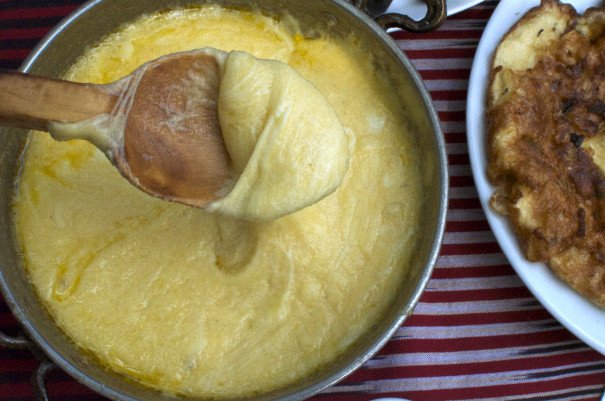
Stuck Outside of Iran With the Trabzon Blues Again

Stuck Outside of Iran With the Trabzon Blues Again
Kuymak by the Black Sea
I am in Trabzon to attain an Iranian visa: the consular process is inexplicably convoluted and the waiting period is unpredictable. The situation would be dire were it not for the fact that I am able to drown my frustrations in kuymak. Few things could survive a kuymak assault: the sludgy-stringy melange of cornflour, cheese, and butter is as dense as freshly mixed concrete and gloopy as lava, with a chewy elasticity that precludes swift consumption. Kahvaltı (breakfast) is an institution in Turkey, and the addition of kuymak—the bubbling pan dotted with white chunks of cheese, yellow pools of butter collecting in the viscous folds—makes the meal feel almost criminal.
Absent from breakfast spreads in Istanbul, kuymak fits snugly in with the dairy-laden cuisine typical of the Black Sea region. Hunkered down on the eastern reaches of Turkey’s northern coastline, Trabzon’s location has long rendered it an important nucleus of trade and travel, and kuymak gestures to a history rich in cultural exchange. Black Sea (Karadeniz) specialties such as fried fish and cornbread have prompted comparisons to the calorific comestibles of the American south, but the idiosyncratic diet arguably owes its quirks to the mercantile wiles of another group entirely.
Trabzon became a major Silk Road staging post in the 8th century, a conduit between Persia, the Far East, and the markets of Europe. Marco Polo stopped here on his homeward journey in the 13th century, when the city was capital of the Empire of Trebizond, the last outpost of Christian Byzantium. In that era, merchants from Polo’s native Venice and their rivals from Genoa dominated the port’s buzzing trade. After Columbus reached the New World in 1492, the Italians are believed to have introduced corn, the staple cereal of the freshly discovered continent, to Turkey. Seen in this light, kuymak looks less like grits and more like a gluttonous Turkish take on polenta.
I eat breakfast under mulberry trees heavy with pale fruit, surrounded by Turkish families sipping tea from delicate tulip-shaped glasses and dipping handfuls of bread into simmering skillets of kuymak. Here, the dish is served as one element of a lavish spread replete with all the usual suspects (tomato, cucumber, cheese, olives, honey) along with Karadeniz flourishes: persimmon jam, a crackly kaygana (herbed omelette), and a slick of local butter. The Byzantine church beyond the swaying tea garden umbrellas has been repurposed as a mosque, its frescoes modestly veiled by a makeshift ceiling. A Turkish bride, her satin hijab brilliant in the uncharacteristic sunshine, poses coyly in front of the defunct bell tower.
Trabzon—a profusion of apartment blocks clinging to the coastline and crawling into the green hills—betrays little of its glorious past. Most historic buildings have been demolished, the churches recycled. Legend has it that the hill jutting prominently out above the central square was once the site of an ancient Mithras cult; it is now carved out into tea gardens and military facilities, construction sites scarring its slopes. A busy highway separates the once famous port town from the sea. Yet Trabzon has not completely lost its significance as a travelers’ hub. Indeed, it is still a crucial stop in an obscure highway of sorts: providing a gateway east into Georgia, and—as in the days of the Byzantine and Ottoman empires—a launching pad into Iran.
Over the course of a leisurely breakfast, the kuymak gradually coagulates. Laboriously scooping up the increasingly unyielding mixture and depositing it dutifully onto my plate, I think of Xenophon. The ancient Greek historian, along with 10,000 mercenaries, was marooned in Trabzon for 30 days while returning home from a military campaign. Beating a retreat from Persia circa 400 BC, the Greek’s internment in the region then known as Pontus was pre-corn, pre-kuymak, pre-Byzantine Empire, pre-Ottomans, and mercifully pre-visa.
Even then, this settlement was a junction: a cultural melting pot and an unlooked-for interlude between the toil of coming and the hustle of going. Satiated, I lean back, looking over an improbably blue Black Sea; the kuymak, heavy like hardening concrete, settles resolutely, reassuringly in my stomach. Luckily, I’m in no hurry.